Let’s explore skateboarding tricks and slang for beginner skateboarders and pros doing skate tricks!
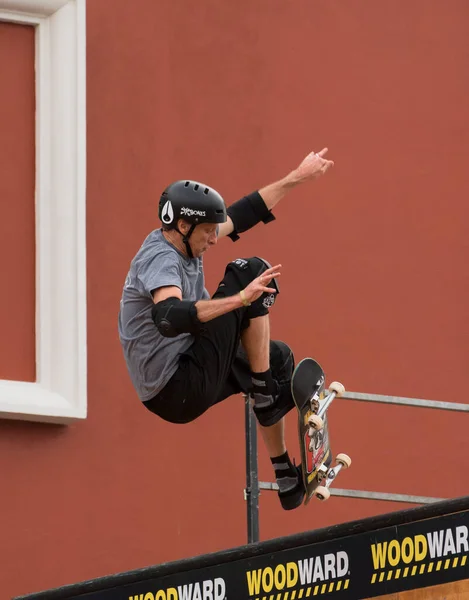
Understanding the terminology is crucial whether you’re a newbie or an experienced rider looking to up your game. We’ll break down everything from basic lingo to gnarly stunts, making it easy for everyone to grasp. We’ll start with simple stunts before moving on to intermediate and advanced ones.
We’ll also introduce various skating styles – like freestyle, street, and vert – that can help add flair to your routine. And don’t worry if you’re not at Tony Hawk’s level yet. We’ve got tips on improving your skills too! So grab your board and get ready – it’s time to speak skater language fluently! Let us know what you think after you’ve tried some of the stunts and styles we mentioned. Let’s explore the capabilities for the board.
Trick Skateboarding
In this article, we will delve into the exciting world of skateboarding with FamilyHype. Whether you are a newbie or an experienced rider, you will understand the essential skateboarding terminology. This is your top guide for learning the names of various tricks and maneuvers.
We will explore basic stunts like the Ollie and Kickflip before moving on to more intermediate and advanced skateboard tricks. As you progress, you’ll explore different styles of riding, such as street riding and ramp riding, complete with slide tricks and tricks grind, to enhance your performance.
With consistent practice and dedication on a ramp or obstacle, you will improve your skills and master challenging skateboard trick list stunts. So get ready to speak the skater language fluently and have a blast on your riding journey, featuring everything from flip tricks to trip tricks!
Skateboard Flip Trick Techniques
Understanding the basics of skateboard trick terminology is essential for anyone looking to enter the skateboard riding world. This sport has its own unique language, filled with terms and names that describe various stunts, maneuvers, and equipment. Learning these terms not only helps you communicate effectively with other riders but also enables you to comprehend instructional materials and videos better.
Some common skateboard riding terminology includes:
- Ollie Skateboarding Tricks: A fundamental skateboard trick where the skateboarder jumps off the ground, bringing the skateboard with them by popping the tail and sliding their front foot up towards the skateboard nose.
- Nollie: Skateboard flip trick techniques involve using the regular stance or nollie, popping the front and rear axle with the deck to flip the board over an obstacle when performed correctly.
- Kickflip Skateboarding Tricks: A skateboard trick where the skateboarder flips the board mid-air using their front foot, making it spin along the length axis.
- Pop Shuvit Skateboarding Tricks: A skateboard trick where the skateboarder spins the board 180 degrees without flip while popping the tail.
- Grind: Trick where the skateboarder slides the skateboard trucks along an edge or rail, using the skateboard’s metal trucks to grind on a surface.
- Skateboard Deck: The main skateboard part of a skateboard, typically made of wood, where the skateboarder stands.
- Skateboard Trucks: Metal T-shaped components that attach the skateboard wheels to the deck and allow the skateboard to turn.
- Skateboard Wheels: Round urethane skateboard components that attach to the skateboard trucks and provide movement and grip. Connect the wheels firmly on the skateboard deck.
- Skateboard Bearings: Small metal skateboard components inside the wheels enable them to spin freely.
- Skateboard Nose: The front end of the skateboard.
- Skateboard Tail: The back end of the skateboard.
- Regular Skateboarding: Riding with the left foot forward.
- Goofy Skateboarding: Riding with the right foot forward. To master this skateboard flip trick, focus on your body’s rotation and whether you ride a regular or goofy stance.
- Pop Shove Skateboarding- Riding and turning your skateboard 180 while staying in the same position.
By familiarizing yourself with these basic terms, you can better understand discussions, tutorials, and instructions related to the sport. As you progress, you’ll encounter more specialized and advanced terminology, but mastering the basics is an excellent starting point.
Skateboard Trick Dictionaries
Now that we’ve got the lingo down let’s get onto the fun part – mastering basic tricks! We will start with learning how to Ollie, a fundamental stunt that forms the basis for many others. Then, we’ll move on to mastering the Kickflip, a more advanced stunt that will impress your friends at the skate park.
Ollie
The Ollie is a fundamental skateboard riding stunt named after Alan ‘Ollie’ Gelfand. To perform it, place your back foot on the tail and your front foot angled towards the nose. Pop the tail, slide your front foot forward, and jump, bringing your knees up to level the board in the air. Land with bent knees and roll away. Mastering the Ollie takes practice with your regular foot, and safety gear is essential.
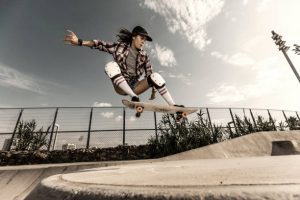
Kickflip
Mastering the kickflip is a significant milestone in skateboard riding. It involves a combination of technique, timing, and commitment. To execute a kickflip, place your back foot on the tail and your front foot angled diagonally on the board. Pop the tail, slide your front foot towards the edge, and flick it to make the board flip beneath you. Bring your feet back over the board as it completes the rotation, and land with your knees bent to absorb the impact. Practice is essential to perfect this stunt with your regular foot; safety gear is vital to prevent injuries.
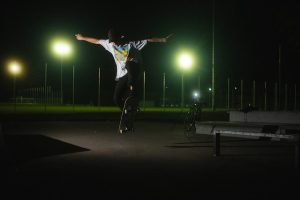
Intermediate Skateboard Stunts
Intermediate skateboard riding stunts open up new possibilities for skaters looking to elevate their skills. These stunts require a solid foundation in basic maneuvers and are a stepping stone toward more advanced stunts. Some popular intermediate stunts include:
- 180 Ollie Tricks: Similar to the basic Ollie trick for skateboarding but with a 180-degree turn in mid-air.
- Pop Shuvit Tricks: A 180-degree spin trick without the board flipping, combining popping and shuvit motion.
- Frontside and Backside 180 Tricks: Turning 180 degrees trick while riding, facing forward (frontside) or backward (backside).
- Boardslide Tricks: A trick that involves sliding the skateboard across a rail or ledge with the skateboard trucks and skateboard wheels perpendicular to the obstacle.
- 50-50 Grind Tricks: Grinding on a skateboard rail or ledge with trucks and wheels.
These intermediate stunts require more control, balance, and coordination, and mastering them will pave the way for tackling even more challenging stunts in the future. As always, safety first! Wear protective gear and practice in safe environments to minimize the risk of injuries.
Advanced Skateboard Tricks
Now that we’ve mastered intermediate tricks, it’s time to improve our skills. We’re about to dive into the challenging world of advanced skateboard riding, focusing on two key aspects: achieving the 360 Flip and mastering various Grind Variations.
Get ready to push your boundaries because these stunts are not for the faint-hearted, but we can nail them with practice and determination!
360 Flip
The 360 flip, also known as the the flip or the 360 kickflip, is a highly sought-after skateboard riding stunt that combines a kickflip and a 360-degree spin. Achieving this stunt requires a solid foundation in basic maneuvers and intermediate tricks.
To perform a 360 flip:
- Start with your back foot on the skateboard tail and your front foot in the kickflip position.
- Pop the tail down and jump while flicking your front foot diagonally forward and outward to initiate the kickflip motion on the skateboard.
- Use your front foot to guide the skateboard in a 360-degree spin as the board flips.
- Keep your eyes on the skateboard and try to catch it with your back foot as it completes the rotation.
- Land with both feet over the bolts and maintain your balance to ride away smoothly. Balance is important whether performing tricks or if the skater is standing alone with their feet.
The 360 flip is a challenging stunt that requires precision and commitment. Practice and repetition are key to mastering this advanced maneuver. It’s important to be patient and keep trying because when you finally manage to do a 360 flip, it’s a big accomplishment in your journey of learning stunts on your board. Remember to wear protective gear and skate in safe environments while attempting this stunt to ensure your safety.
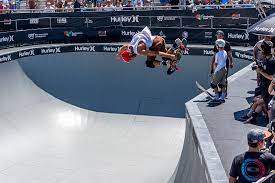
Grind
Grinding is a fundamental technique that involves sliding along a surface using the trucks of your board. There are various grind variations, each offering its unique challenges and excitement. Here are some popular grind variations to explore:
- 50-50 Grind: In this classic skateboard grind trick, both skateboard trucks slide along the edge of the rail, ledge, or coping.
- Boardslide: For this skateboard grind trick, the board slides perpendicular to the rail or ledge, with the center of the board making contact.
- 5-0 Grind: In a 5-0 skateboard grind trick, the back truck slides along the rail or ledge, while the front truck remains suspended in the air.
- Nosegrind: The skateboard nosegrind trick only involves sliding along the rail or ledge with the front truck.
- Smith Grind: In a skateboard Smith grind, the front truck grinds on the rail or ledge, and the back truck is suspended.
- Feeble Grind: The feeble grind trick is similar to the smith grind but performed with the back truck grinding.
- Crooked Grind: The skateboard is angled in this grind, and only one set of skateboard wheels and trucks slide along the rail or ledge.
- Salad Grind: A combination of a skateboard slide and a 50-50 grind, where the skateboard is at an angle, and both skateboard trucks slide.
- Overcrook Grind: The opposite of the crooked grind, where the back truck hangs over the rail or ledge.
Mastering grind variations requires practice, balance, and commitment. Start with basic grinds and gradually progress to more challenging ones as you build confidence and skill.
Skating Styles
We’ve had a blast learning about advanced stunts, haven’t we? Skating styles include tricks like the tic tac, riding fakie, using the underside of the tail for balance, and performing flip tricks.
Now, let’s shift gears and dive into the distinct styles of skateboard riding: Street Skating and Vert Skating. Both styles bring their own unique challenges and thrills to the table, shaping the way skaters interact with their environment and define their skill sets.
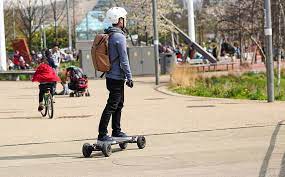
Skating Tricks
To perform skateboard tricks, a regular-footed rider uses their left foot to control the tail of the board, while switching stance involves moving to a switch stance with the nose of the board leading instead of the normal stance. Skating tricks you can learn include flat-ground tricks like ollies and kickflips, as well as shaped-ramp or mini-ramp tricks like rock-to-fakies and drop-ins.
Skating tricks like frontside, backside, switch, and top tricks showcase the versatility and skill of a skater.
Street skating is a style in urban environments that uses obstacles like curbs, stairs, and rails for stunts and grinds. It emphasizes creativity, personal expression, and exploration of the city. Despite challenges like rough surfaces and legal restrictions, street skating remains a thrilling and integral part of skateboard riding culture worldwide.
Vert Skating Tricks
Vert skating is a style that takes place on vertical ramps or structures, such as halfpipes or skate bowls. Skaters use the curvature of the ramp or obstacle to gain speed and perform aerial stunts, flips, and spins.
For vert skating tricks, if you’re regular footed, your left foot is forward, and for switch stance, your right foot leads. Vert skating tricks include moves done on a vert ramp or quarter pipe, unlike flat ground or mini ramp tricks, and often involve facing the ramp or obstacle to perform aerial maneuvers.
Vert skating requires a high level of skill, balance, and fearlessness as skaters launch into the air and perform complex maneuvers above the ramp’s coping. It is a challenging and adrenaline-pumping form of skateboard riding, often associated with professional competitions and events.
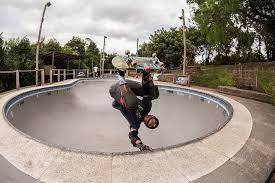
Trick Skating
Skateboard riding is more than just a hobby or a way of life; it’s an art form, and like any other form of art, it takes dedication and practice to master. Here at FamilyHype, we believe that this sport is a great way to bring families together and create a strong bond between parents and their kids.
To assist you in your journey, we’ve compiled a trick list designed to help you sharpen your skills and take your skateboard riding to the next level. That’s why we have compiled a few tips to help you sharpen your skills and take your skateboard riding to the next level.
- Practice skateboarding regularly: Consistent practice is essential for improving your skateboard tricks.
- Master the skateboard basics: Before attempting advanced skate tricks, make sure you have a solid foundation of basic skills.
- For skateboard tricks, try placing your left foot near the nose of the board, and your right foot on the tail of the board, practice switching between regular footed and switch stance, and perfect your normal stance for better control.
- For trick skating tips, if you’re regular footed, keep your left foot forward and practice shifting your weight and balance smoothly for better control. Balance yourself well, even if the skater is standing alone on the board or performing tricks.
- Focus on mastering techniques like using grip tape for better control and understanding how a pivot cup affects board movement and stability.
- Practice on flat ground, mini ramps, and vert ramps; start by facing the ramp or quarter pipe to get comfortable with different tricks.
- Watch skateboarding videos and learn: Watch videos of skilled skateboarders and observe their techniques and movements. Rest on curbs, benches, and more as you watch.
- Start small and progress gradually: Begin with easy skateboard tricks and gradually challenge yourself with more difficult skate tricks.
- Seek guidance from experienced skaters: Skating with more experienced skaters can be a great way to learn new skills.
- Work on your skateboard balance: Improving your balance is crucial for mastering tricks and maintaining control while riding.
- Visualize success: Mental preparation is just as important as physical practice. Visualize yourself successfully executing a skateboard trick before attempting it. Think that you are successful on your trick performed.
- Stay persistent and patient: Skateboard riding requires perseverance and patience. Some tricks may take time to master but don’t get discouraged.
- Use protective gear for skateboarding: Safety should always be a priority.
- Have fun and be creative: Skateboard riding is all about enjoying the ride, tricks and expressing yourself.
Conclusion
Understanding skateboard riding terminology is essential whether you’re a beginner or an experienced rider. We’ve covered everything from basic lingo to gnarly stunts, ensuring everyone can grasp the skateboarding language. Starting with simple stunts like the Ollie and Kickflip, we’ve progressed to intermediate and advanced maneuvers, focusing on achieving the 360 Flip and mastering various Grind Variations.
Along the way, we’ve introduced the distinct styles of Street Skating and Vert Skating, each offering unique challenges and thrills. Remember, with consistent practice and dedication, you can improve your skills and take on more challenging stunts. Our tips are here to guide you on your skateboarding journey, helping you refine your technique and unleash your creativity.
Skateboarding isn’t just a hobby; it’s an art form that can bring families together and create lasting bonds. We’re thrilled to be part of your adventure, and we can’t wait to hear about your experiences, favorite tricks, and progress. So, get out there, have fun, and enjoy the ride! Stay safe, and remember that skateboarding is about passion, expression, and pushing your boundaries. Happy shredding!
Frequently Asked Questions:
What’s A 50-50 Skateboarding Trick In Skateboard Slang?
A 50-50 is a skateboard stunt where the skateboarder grinds along a rail, ledge, or coping with both trucks and wheels, effectively sliding the entire length of the obstacle. Additionally, it’s worth noting that grab stunts, such as the indy grab, are another element of skateboard riding that allows riders to add their unique flair and creativity to their tricks. With a variety of flip tricks, slide tricks, and grab tricks to explore, skateboarders continue to push the boundaries of what’s possible on a skateboard.
What’s A 1080 Skateboard Trick In Skateboard Slang?
1080 is an incredibly difficult and rare skateboard stunt in which the skateboarder completes three full rotations (or spins) mid-air before landing.
What’s 5-0 Skate Tricks In Skateboard Slang?
A 5-0 (pronounced “five-oh”) is a skateboard stunt where the skateboarder grinds along a rail or ledge using only the back truck, while the front truck remains suspended in the air.
What’s A 180 Skateboard Trick In Skateboard Slang?
A 180 is a basic skateboard stunt where the skateboarder performs a 180-degree turn either in mid-air or on the ground, effectively changing their direction. The rider initiates the 180 by using their body and foot movements to pivot the board 180 degrees while maintaining control and balance.
This stunt can be performed on flat ground, on a ramp or obstacle, or while riding down a slope. The 180 is a fundamental maneuver that sets the stage for more complex stunts like the kickflip underflip, where the rider combines a kickflip and a 180-degree spin, and the half cab, a 180-degree turn trick performed while riding a fakie.
What’s A Caballero Flip In Skateboard Tricks Slang?
A Caballero flip, also known as a “360 flip” or “tre flip,” is a popular stunt invented by Rodney Mullen. This trick falls under flip tricks, which involve manipulating the skateboard mid-air to execute rotations and flips. In a Caballero flip, the skateboarder performs a kickflip and a board flip along the length axis, adding a 360-degree spin to the trick. The result is a stylish and impressive maneuver that showcases the skater’s skill and control.
What’s Slang For “Skateboard”?
The skateboarding terms or slang for ‘skateboard’ include terms like ‘deck’ or ‘board,’ used in skateboarding for tricks like “grind a grind” or tricks popularized by Rodney Mullen.
What’s A Hurricane Skate Trick?
A hurricane is a skateboard trick where the skateboarder grinds along a rail or ledge with the board perpendicular to the obstacle and all four wheels making contact. This trick is a flip trick where the skater rotates the board 180 degrees while balancing on two wheels using grip tape and pivot cups for stability and control, often combined with a tic tac for added style and difficulty.
Is There A Skateboard Trick Called Impossible?
Yes, the “impossible” is a skateboard trick where the skateboarder flips the board 360 degrees along the width axis using their back foot, making it appear as if the board spins impossibly without touching it with their front foot. In skateboard riding, there are many other stunts like the rocket air and the Christ air, which are aerial tricks that involve grabbing the skateboard in mid-air to add style and creativity to the rider’s movements.
The sex change is a trick where the rider performs a 180-degree turn while hopping off the board and then landing back on it, effectively switching their stance. The body varial is another trick where the rider rotates their body 180 degrees while keeping the board in the same position, creating a visually impressive and stylish move.
What’s A Dolphin Flip In Skateboard Tricks Slang?
A dolphin flip, also known as the “forward flip” or “540 flip,” is an advanced skateboard trick where the skateboarder performs a kickflip while simultaneously rotating the board 540 degrees along the length axis. It is a challenging and rare trick to perform with your skate wheel. For more experienced skateboarders, there are advanced stunts like the roll-in, which involves dropping into a ramp or obstacle, or bowl and quickly gaining speed, and the acid drop, where the rider jumps from a higher surface onto the skateboard below.
These main tricks hark back to the old-school era of skateboard riding, where riders pushed the boundaries of what was possible on a skateboard and laid the foundation for the diverse and exciting world of skateboard riding stunts we know today.
What Is It Called When You Jump On A Skateboard?
When you jump on a skateboard, it’s called an ollie, which is one of the basic skateboarding terms invented by Alan Gelfand and adapted by Rodney Mullen, allowing skaters to get air and perform tricks like “Grind A Grind” or grinding on a flat section.
” The Ollie is a fundamental skateboard riding stunt that forms the basis for many other maneuvers. To perform an Ollie, the skateboarder places their back foot on the tail and their front foot angled towards the nose. By popping the tail and sliding their front foot up towards the nose, the rider can lift both the board and themselves off the ground.
This stunt showcases the skater’s ability to control the board and is the foundation for more advanced moves like the frontside flip, fakie ollie, and pop shove it. Additionally, skateboarders can incorporate Ollies into various combinations, such as the pop shove and the alley-oop, to add style and flair to their skateboard riding routine.
Another skill that skateboarders often practice is the nose manual, which involves balancing on the front wheels while the back of the board is raised off the ground, as well as the blunt stall, where the rider balances on the back truck while the tail is positioned on a ledge or obstacle. With a wide array of tricks, including slide stunts, grab stunts, and flip stunts; skateboard riding offers a diverse and exciting range of maneuvers for riders to explore and master.
Last Updated on July 6, 2024 by Jayvel De Guzman
DISCLAIMER (IMPORTANT): This information (including all text, images, audio, or other formats on FamilyHype.com) is not intended to be a substitute for informed professional advice, diagnosis, endorsement or treatment. You should not take any action or avoid taking action without consulting a qualified professional. Always seek the advice of your physician or other qualified health provider with any questions about medical conditions. Do not disregard professional medical advice or delay seeking advice or treatment because of something you have read here a FamilyHype.com.